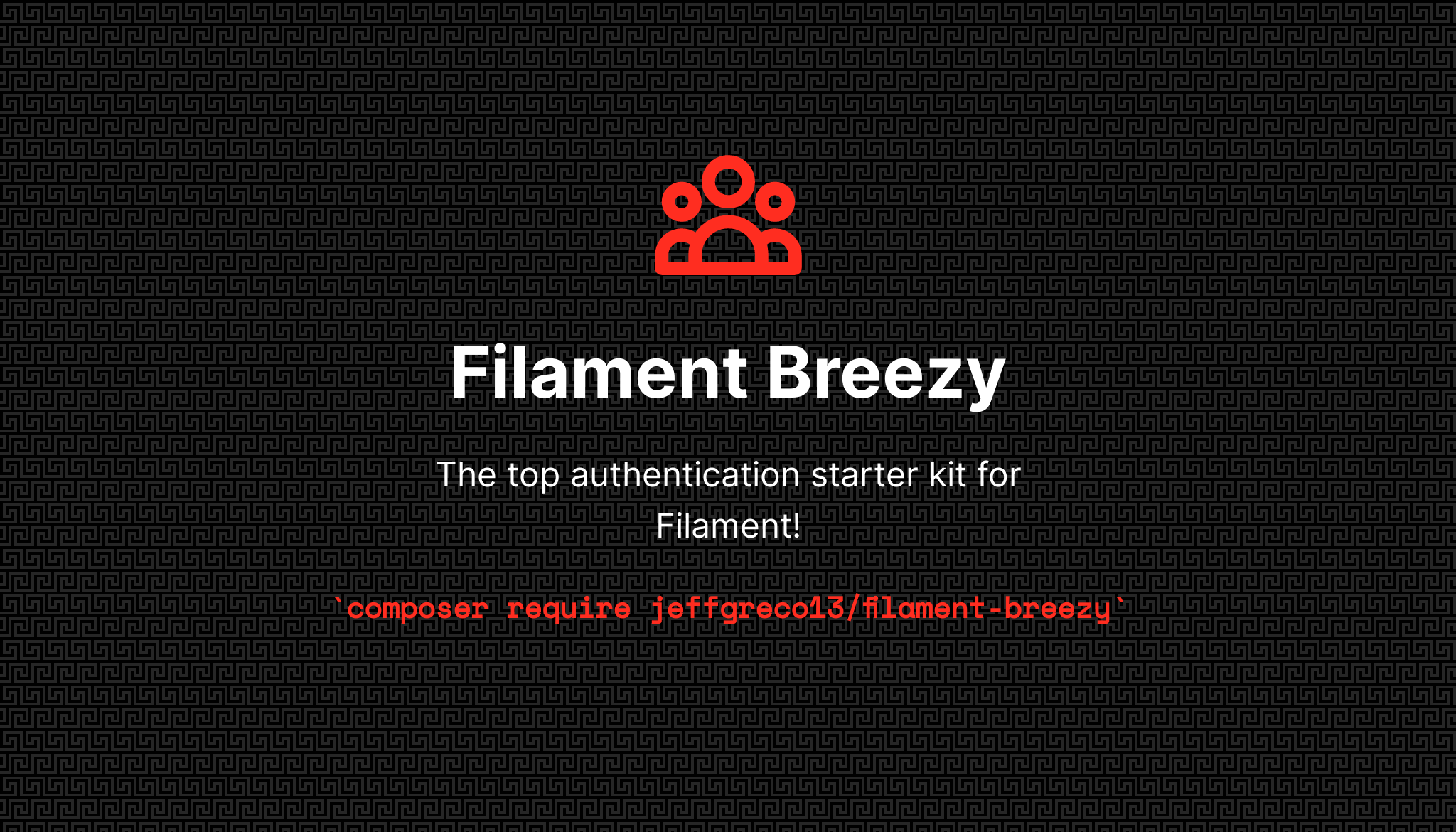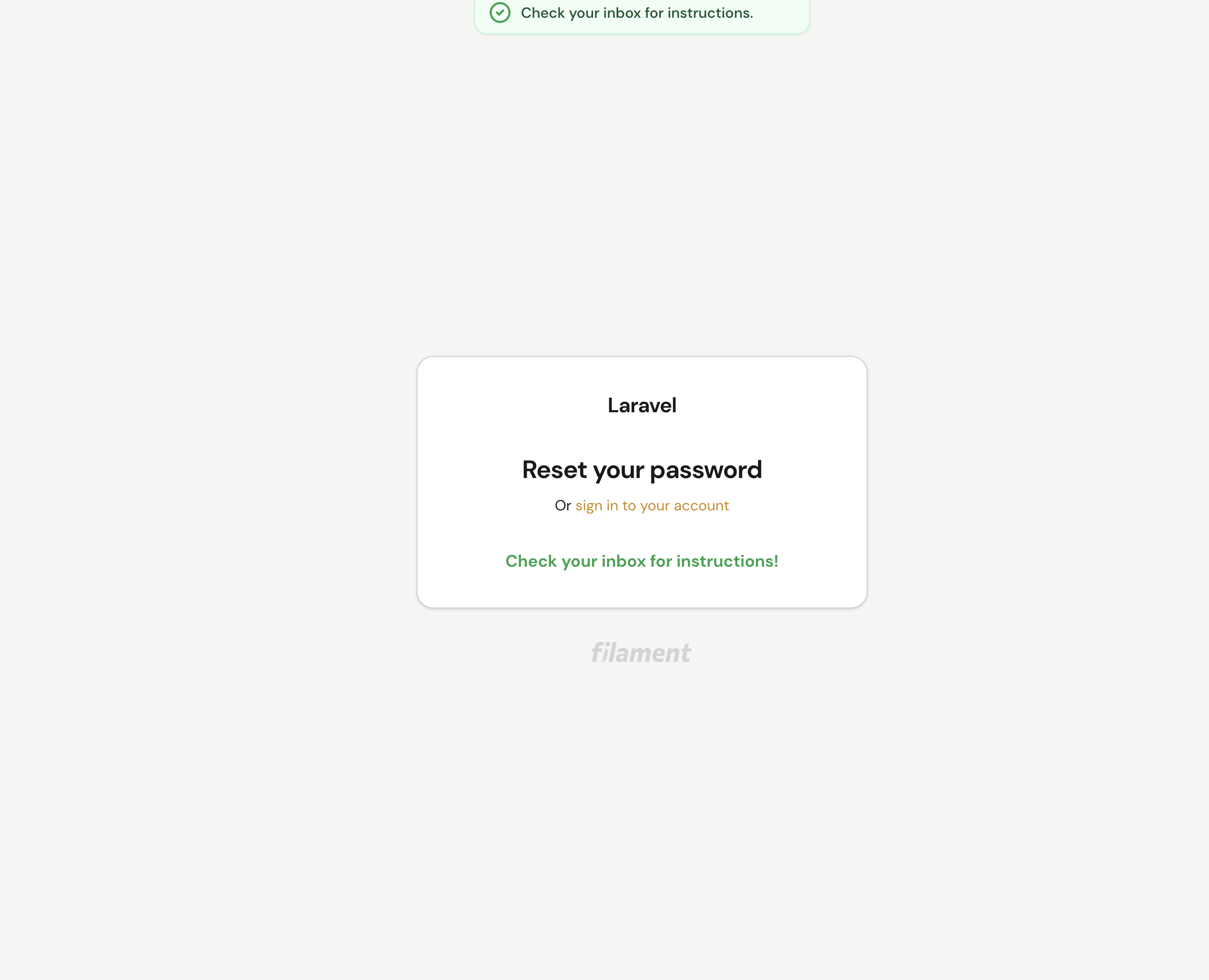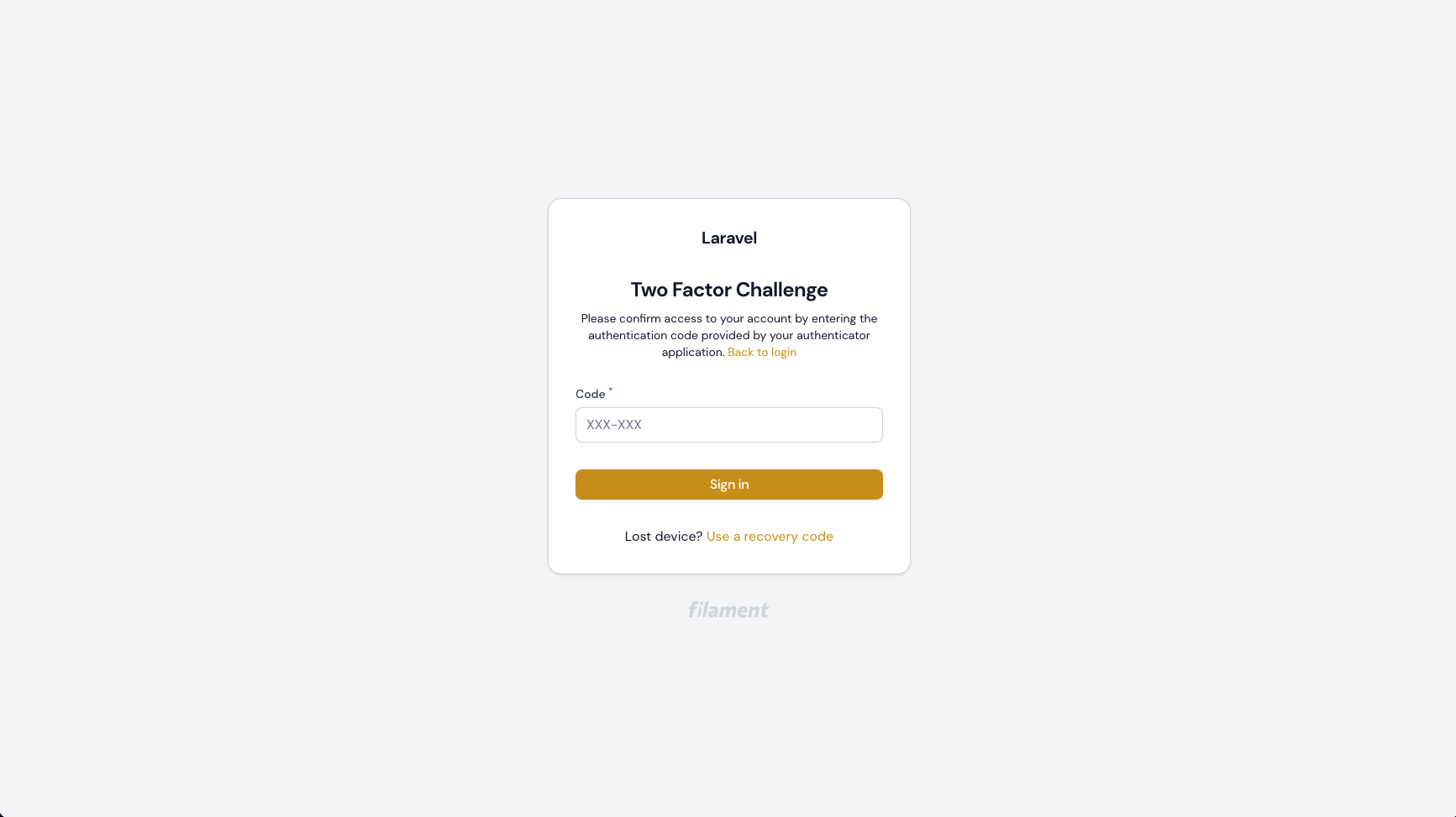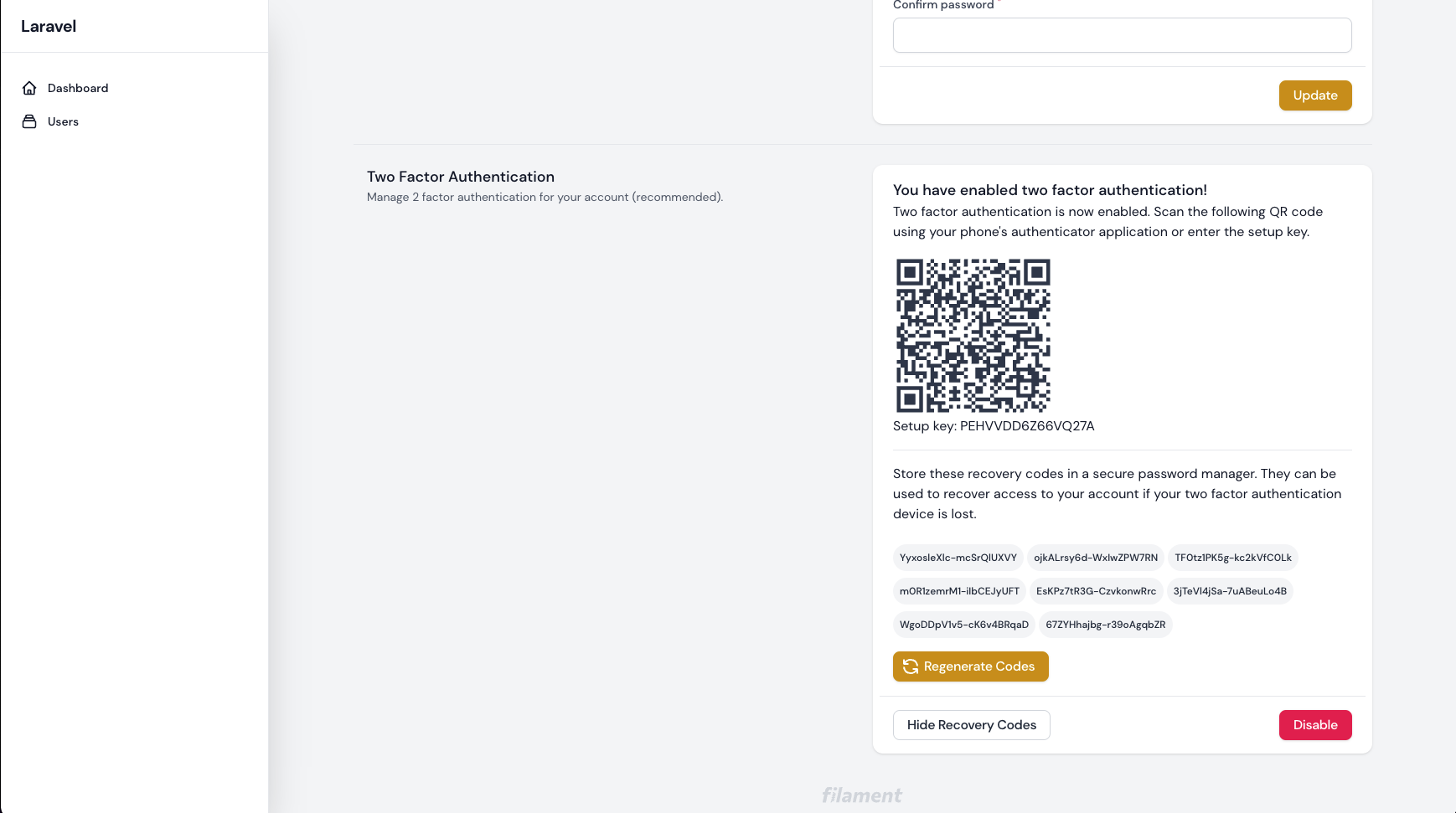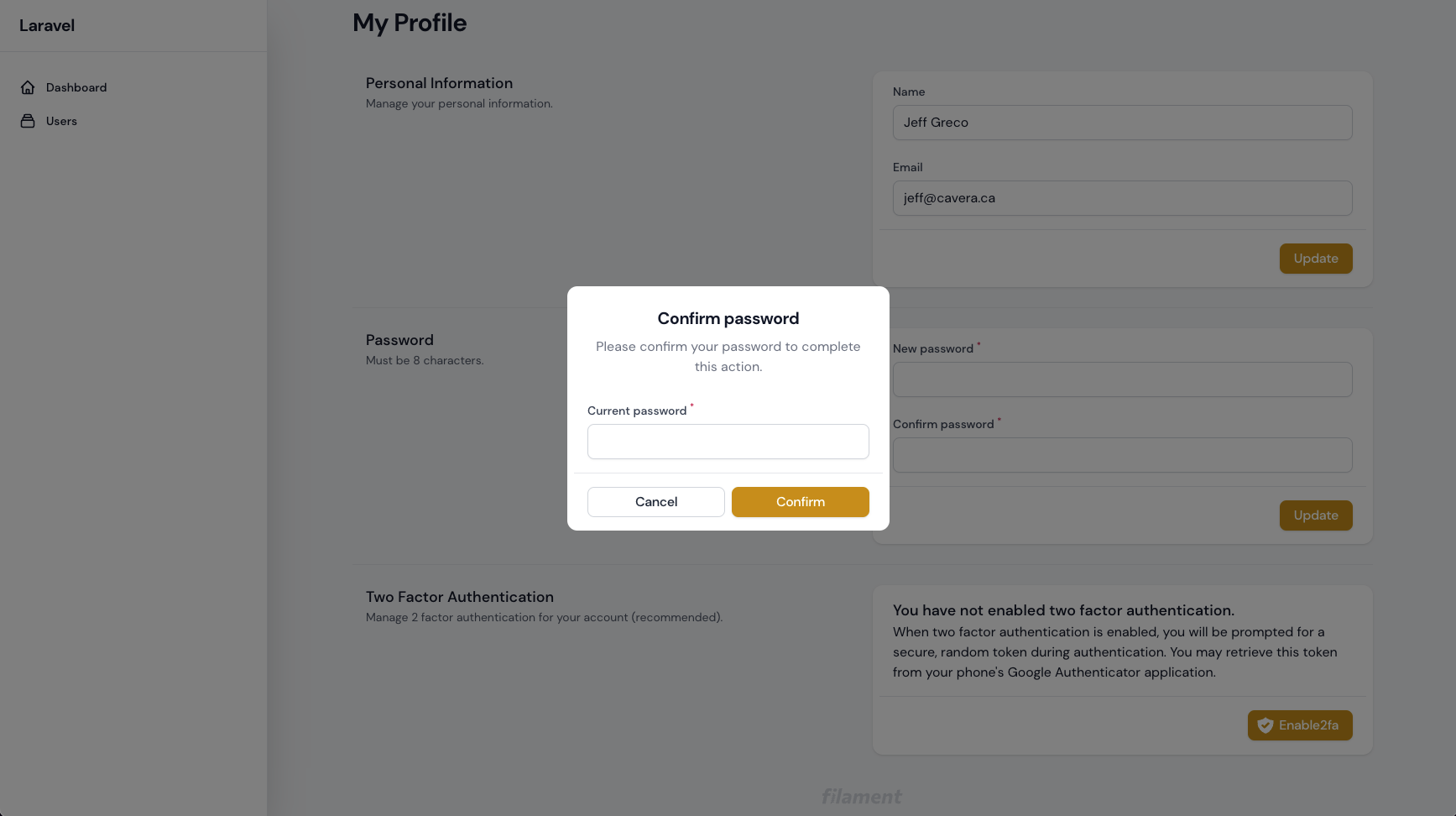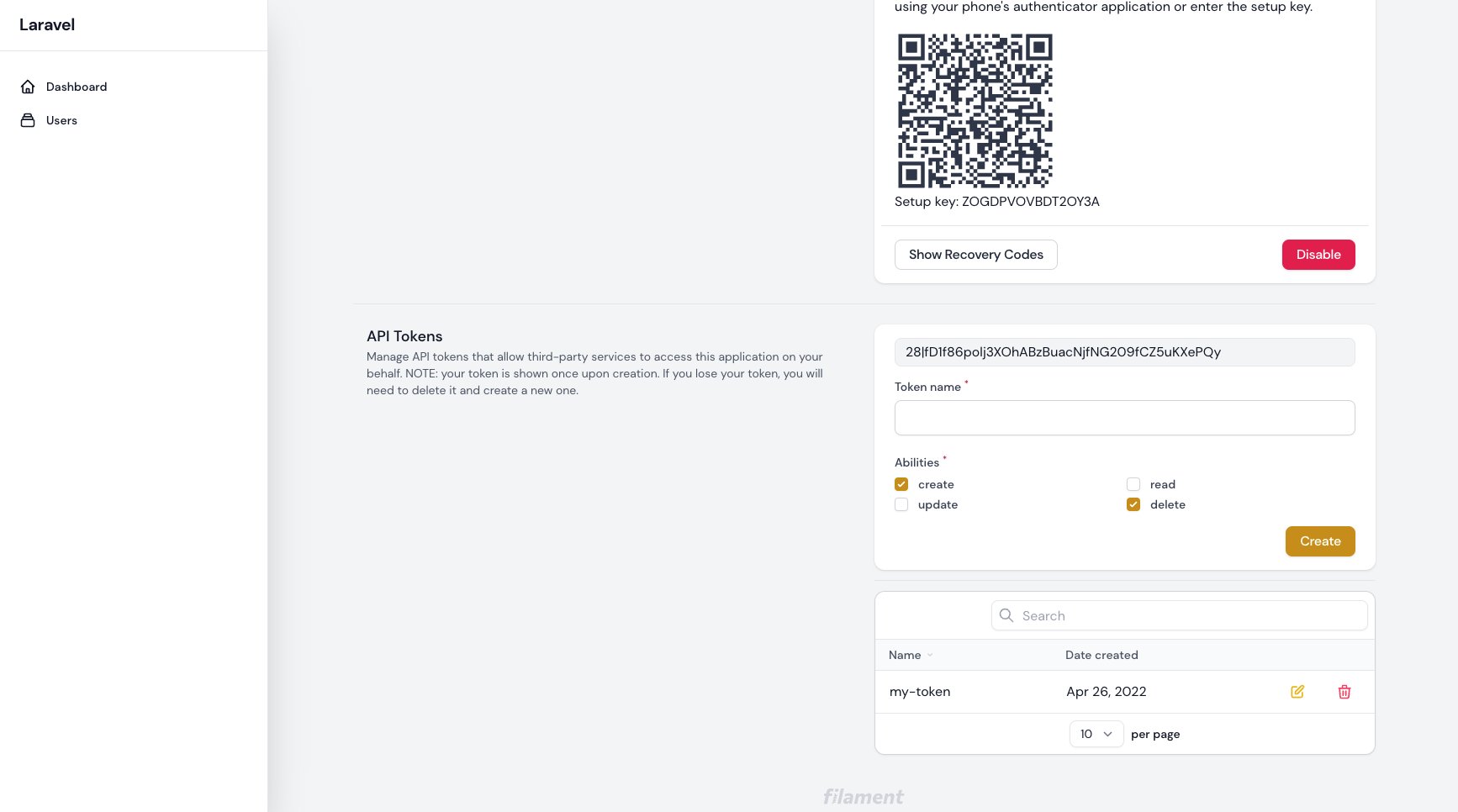laragis / filament-breezy
A custom package for Filament with login flow, profile and teams support.
Fund package maintenance!
jeffgreco13
Installs: 3
Dependents: 0
Suggesters: 0
Security: 0
Stars: 0
Watchers: 0
Forks: 170
pkg:composer/laragis/filament-breezy
Requires
- php: ^8.0|^8.1
- bacon/bacon-qr-code: ^2.0
- filament/filament: ^2.15
- illuminate/contracts: ^8.0|^9.0|^10.0
- pragmarx/google2fa: ^7.0|^8.0
- spatie/laravel-package-tools: ^1.9.2
Requires (Dev)
- nunomaduro/collision: ^5.0|^6.0
- nunomaduro/larastan: ^1.0
- orchestra/testbench: ^6.0|^7.0|^8.0
- pestphp/pest: ^1.21
- pestphp/pest-plugin-laravel: ^1.1
- phpstan/extension-installer: ^1.1
- phpstan/phpstan-deprecation-rules: ^1.0
- phpstan/phpstan-phpunit: ^1.0
- phpunit/phpunit: ^9.5
- spatie/laravel-ray: ^1.26
This package is auto-updated.
Last update: 2026-01-06 07:48:03 UTC
README
The top authentication starter kit for Filament Admin!
The missing toolkit from Filament Admin with Breeze-like functionality. Includes login, registration, password reset, password confirmation, email verification, and a my profile page. All using the TALL-stack, all very Filament-y.
Screenshots
Warning: Jetstream or Breeze Users
Please read the Routing instructions before installing to ensure that Filament Breezy will suit your needs.
Installation
- Install the package via composer:
composer require jeffgreco13/filament-breezy
- Update the
config/filament.phpto point to the Breezy Login::class.
"auth" => [ "guard" => env("FILAMENT_AUTH_GUARD", "web"), "pages" => [ "login" => \JeffGreco13\FilamentBreezy\Http\Livewire\Auth\Login::class, ], ],
Optionally, you can publish the Breezy config file for further customizations, such as Password rules, redirect after registration, and enable/disable the profile page.
php artisan vendor:publish --tag="filament-breezy-config"
Optionally, you can publish the views using:
php artisan vendor:publish --tag="filament-breezy-views"
Enable Two Factor Authentication (2FA)
By default, 2FA is disabled. To enable it Two Factor Authentication in your app:
- Set
enable_2fa => truein the filament-breezy config:
/* |-------------------------------------------------------------------------- | Enable Two-Factor Authentication (2FA). */ "enable_2fa" => true,
NOTE: if you are using a table other than users, you can update the table name in the filament-breezy config or modify the published migration.
- Publish and run the migrations:
php artisan vendor:publish --tag="filament-breezy-migrations"
php artisan migrate
- Add
JeffGreco13\FilamentBreezy\Traits\TwoFactorAuthenticatableto your Authenticatable model:
use JeffGreco13\FilamentBreezy\Traits\TwoFactorAuthenticatable; class User extends Authenticatable { use HasApiTokens, HasFactory, Notifiable, TwoFactorAuthenticatable; ...
Usage
Routing
COMPATIBILITY WARNING
Breezy uses the default Laravel Auth routes, register, login, password.request, password.reset, verification.verify and verifciation.notice in order to deliver a seamless experience with Laravel Auth. If you are using Jetstream, Breeze, or another plugin that uses the default auth routes then you will get an error that the routes are already registered.
You can use the "route_group_prefix"=>'', option in the Filament Breezy config file to set a name prefix for all of Breezy's routes. Ex. "route_group_prefix"=>'breezy.',
However, since Breezy uses Laravel Auth to generate password reset and email verfication emails you will need to customize these emails to use the appropriate routes. For example, a user resetting their password from Filament Breezy will receive an email directing them to the password.reset route because Laravel Auth generates the URL in this email automatically.
Please see instructions for Password Reset Customization and Email Verification Customization for instructions on how to customize these URLs to suit your needs.
Customizing Password Rules
The registration, my profile and password reset forms use the same set of password validation rules. You can add new rules to the array from the filament-breezy.php config file:
"password_rules" => ['min:8'],
If you would like to use an instance of Illuminate\Validation\Rules\Password::class for validation, you can register new rules from the boot() method of your AppServiceProvider:
use Illuminate\Validation\Rules\Password; public function boot() { FilamentBreezy::setPasswordRules( [ Password::min(8) ->letters() ->numbers() ->mixedCase() ->uncompromised(3) ] ); }
Email Verification
Uses the Laravel Email Verification service.
Implement MustVerifyEmail on your User model:
use Illuminate\Contracts\Auth\MustVerifyEmail; class User extends Authenticatable implements MustVerifyEmail
Then you can add the verified middleware to any of your routes:
Route::get("/profile", function () { // Only verified users may access this route... })->middleware('verified');
Or, if you're using a custom route name prefix:
Route::get("/profile", function () { // Only verified users may access this route... })->middleware('verified:my-prefix.verification.notice');
To force verified emails on your entire Filament Admin by adding the verified class to the auth middleware in config/filament.php:
"middleware" => [ "auth" => [ Authenticate::class, 'verified' ], ....
Extending and Overriding Components
All pages within the auth flow are full-page Livewire components made to work with Filament Forms. So you can easily extend any component to add your own fields and actions.
You can instruct Breezy to use any custom components by updating the paths in the filament-breezy config file:
/* |-------------------------------------------------------------------------- | Path to registration Livewire component. */ "registration_component_path" => \JeffGreco13\FilamentBreezy\Http\Livewire\Auth\Register::class, /* |-------------------------------------------------------------------------- | Path to password reset Livewire component. */ "password_reset_component_path" => \JeffGreco13\FilamentBreezy\Http\Livewire\Auth\ResetPassword::class, /* |-------------------------------------------------------------------------- | Path to email verification Livewire component. */ "email_verification_component_path" => \JeffGreco13\FilamentBreezy\Http\Livewire\Auth\Verify::class,
NOTE: Remember, the Login path is set in the Filament config, not in the filament-breezy config.
Here is an example of extending the BreezyRegister class to add new fields to registration:
use JeffGreco13\FilamentBreezy\Http\Livewire\Auth\Register as FilamentBreezyRegister; class Register extends FilamentBreezyRegister { // Define the new attributes public $consent_to_terms, $team_name; // Override the getFormSchema method and merge the default fields then add your own. protected function getFormSchema(): array { return array_merge(parent::getFormSchema(),[ Forms\Components\Checkbox::make('consent_to_terms')->label('I consent to the terms of service and privacy policy.')->required(), Forms\Components\TextInput::make("team_name")->required() ]); } // Use this method to modify the preparedData before the register() method is called. protected function prepareModelData($data): array { $preparedData = parent::prepareModelData($data); $preparedData['consent_to_terms'] = $this->consent_to_terms; $preparedData["team_name"] = $this->team_name; return $preparedData; } // Optionally, you can override the entire register() method to customize exactly what happens at registration public function register() { $preparedData = $this->prepareModelData($this->form->getState()); $team = Team::create(["name" => $preparedData["team_name"]]); unset($preparedData["team_name"]); // ... } ...
Extending and Customizing the Profile Page
Similar to above, you can add new fields to your Profile forms by extending the Filament Page:
namespace App\Filament\Pages; use JeffGreco13\FilamentBreezy\Pages\MyProfile as BaseProfile; use Filament\Forms; class MyProfile extends BaseProfile { // .. protected function getUpdateProfileFormSchema(): array { return array_merge(parent::getUpdateProfileFormSchema(), [ Forms\Components\TextInput::make("job_title"), Forms\Components\Checkbox::make("marketing_consent")->label( "I consent to receive email notifications....." ), ]); }
You will then need to set "enable_profile_page" => false, in filament-breezy config to unregister the default Profile page. When you set "enable_profile_page" => false, then "show_profile_page_in_user_menu" => true is ignored and you will need to manually register a new item for the user menu within your service provider:
use App\Filament\Pages\MyProfile; Filament::serving(function () { // .. Filament::registerUserMenuItems([ 'account' => UserMenuItem::make()->url(MyProfile::getUrl()), ]); // .. });
NOTE: in order to add new sections to the Profile page, you will need to extend the class and publish/create your own views. The above method will only allow for adding new fields to the existing Personal Information or Password forms.
Using a Column Other Than email for Login
You may want to authenticate your users using a column other than email in your Authenticatable model. After you have setup your database, you can change the column in the config:
"fallback_login_field" => "username",
Optionally, update the field label in your language file:
"fields" => [ // "login" => "Username", //
Password Confirmation Button Action
Since v1.3.0, Breezy has a PasswordButtonAction shortcut which extends the default Page\ButtonAction class. This button action will prompt the user to enter their password for sensitive actions (eg. delete), then will not ask for password again for the # of seconds defined in the filament-breezy config (default 300s).
use JeffGreco13\FilamentBreezy\Actions\PasswordButtonAction; PasswordButtonAction::make('secure_action')->action('doSecureAction') // Customize the icon, action, modalHeading and anything else. PasswordButtonAction::make('secure_action')->label('Delete')->icon('heroicon-s-shield-check')->modalHeading('Confirmation')->action(fn()=>$this->doAction())
Sanctum API Tokens
The most recent version of Laravel include Sanctum, but if you don't already have the package follow the installation instructions here.
As soon as Sanctum is installed, you are ready to allow users to create new API tokens from the Profile page. Enable this option in the config:
enable_sanctum => true
You can then control the available permissions abilities from the config, which will add each ability as a checkbox:
"sanctum_permissions" => ["create", "read", "update", "delete"]
Follow the Sanctum instructions for authenticating requests as usual.
Testing
composer test
Changelog
Please see CHANGELOG for more information on what has changed recently.
Contributing
Please see CONTRIBUTING for details.
Security Vulnerabilities
Please review our security policy on how to report security vulnerabilities.
Credits
License
The MIT License (MIT). Please see License File for more information.

